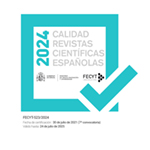Alfareros de aquí o de allá: Identidad estilística y tecnológica en el valle de Pachacamac (costa central peruana)
Resumen
El reconocimiento de identidades étnicas y políticas previas a la conquista española en Perú se ha basado tradicionalmente en los estilos cerámicos. En la costa central, aprovechando la existencia de fuentes sobre la cuenca del Lurín, se ha sugerido que los ayllus costeños se servían preferentemente de la cerámica utilitaria de estilo Ychsma, que definiría también a la cultura del mismo nombre; los habitantes de la cabecera del valle (Huarochirí) habrían utilizado recipientes cerámicos del estilo llamado «Serrano». La frecuente aparición de este segundo estilo en los sitios excavados o prospectados en el valle bajo del Lurín, se ha interpretado como prueba de la presencia e importancia política serrana en la costa. El artículo contrasta esta hipótesis mediante el análisis de Espectrometría de Masas por Ablación Láser con fuente de Plasma de Acoplamiento Inductivo (LA-ICP-MS) de 600 fragmentos de cerámica del valle bajo, medio y alto del Lurín y 116 muestras de arcilla de los valles del Chillón, Rímac, Lurín y Chilca, procesando los resultados mediante estadística multivariante y análisis espacial (SIG) con objeto de correlacionar conjuntos de alfares y grupos estilísticos con las áreas de extracción de la materia prima. Los resultados finales muestran que el valle del Lurín y el valle del Rímac tuvieron cada uno su propia tradición estilística y tecnológica en las vasijas de uso utilitario; indican, asimismo, que el hipotético «Estilo Serrano» caracteriza a la producción de alfareros del valle del Lurín, mientras que el estilo Ychsma se produce principalmente en el valle del Rímac. Estas conclusiones obligan a reinterpretar las relaciones entre sierra y costa durante el Horizonte Tardío, incluyendo el comienzo del Periodo Colonial, y a someter a crítica la existencia de la «cultura Ychsma» en el territorio del hipotético señorío del mismo nombre.
Descargas
Descarga artículo
Licencia
La Revista Española de Antropología Americana, para fomentar el intercambio global del conocimiento, facilita el acceso sin restricciones a sus contenidos desde el momento de su publicación en la presente edición electrónica, y por eso es una revista de acceso abierto. Los originales publicados en esta revista son propiedad de la Universidad Complutense de Madrid y es obligatorio citar su procedencia en cualquier reproducción total o parcial. Todos los contenidos se distribuyen bajo una licencia de uso y distribución Creative Commons Reconocimiento 4.0 (CC BY 4.0). Esta circunstancia ha de hacerse constar expresamente de esta forma cuando sea necesario. Puede consultar la versión informativa y el texto legal de la licencia.









